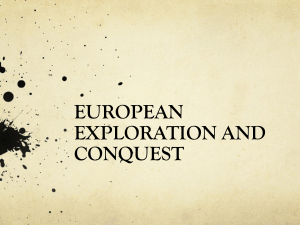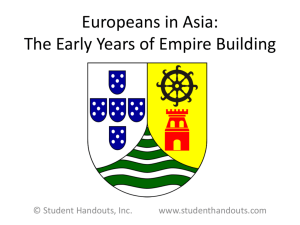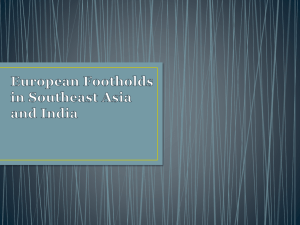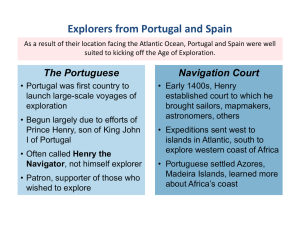1.1) Ch 22 Lecture PowerPoint
advertisement
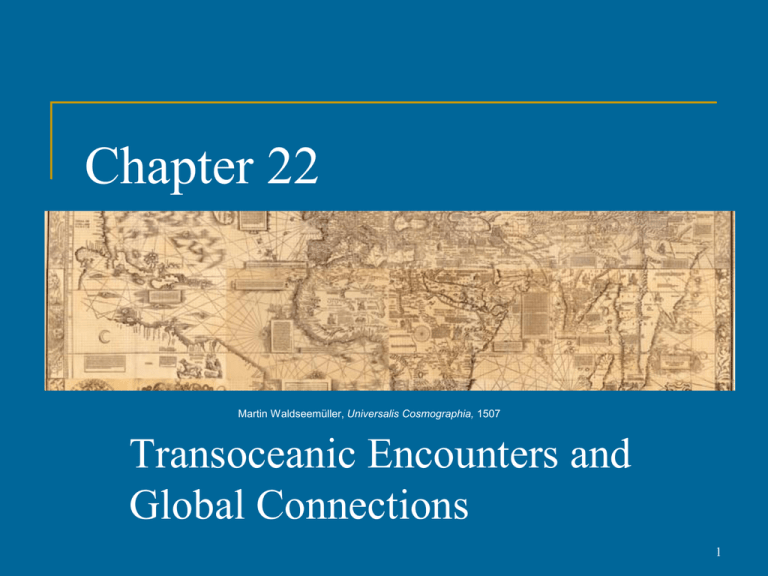
Chapter 22 Martin Waldseemüller, Universalis Cosmographia, 1507 Transoceanic Encounters and Global Connections 1 Why Portugal? Portuguese flag in the 1400s Portugal: a relatively resource- and land-poor country. Beginning in the 1300s, Portuguese begin sailing into the open Atlantic, mainly for fishing, whaling, and land Claimed Madeira Islands (settled ca. 1420) and Azores (settled 1433) in the Atlantic Acquisition of islands to plant profitable sugarcane 2 Why Portugal? 3 The Lure of Trade Asian Luxury Items: spices, silk, porcelain Overland silk roads more dangerous since spread of bubonic plague outbreak began in 1346 Prices and profits on Asian goods increase in the 1400s with Ottoman dominance (conquest of Constantinople in 1453); Venice a trading leader Indian pepper, Chinese ginger increasingly essential to diet of European wealthy classes Sub-Saharan African Trade: gold, ivory, slaves 4 Missionary Efforts Franciscan, Dominican missionaries to India, central Asia and China Violent efforts with crusades, reconquista – leant a religious element to encounter with native peoples across the globe When Vasco da Gama reached Calicut in 1498, he told authorities he was looking for “Christians and spices” (Indian Christians had existed since the first century A.D. due to the overland trek of St. Thomas the Apostle) 5 The Technology of Exploration Chinese rudder introduced in twelfth century Square sails replaced by triangular lateen sails Navigational instruments Work better with cross winds Astrolabe (from Arabs) measures latitude Magnetic compass (from China) to find north Knowledge of winds, currents The volta do mar 1500s brass astrolabe “Return through the sea” 6 Wind and Current Patterns in the World’s Oceans 7 Portuguese Breakthroughs Prince Henry of Portugal (1394-1460) Promoted exploration of west African coast Established fortified trading posts 1488, Bartolomeu Dias rounds Cape of Good Hope, enters Indian Ocean basin Storms and restless crew force return Vasco da Gama reaches India by this route, 1497 By 1500, Portuguese establish a trading post at Calicut 8 Christopher Columbus (1451-1506) Believed Earth was smaller Estimated Japan approximately 2,500 miles west of Canaries (actually 10,000 miles) John II of Portugal refuses to fund the proposed westward trip since his experts thought Columbus’s calculations were way off Fernando and Isabel of Spain sponsor voyage, but Italian bankers underwrite it Five weeks from the Canaries he lands in the Bahamas; also lands on Cuba and Hispaniola 9 Hemispheric Links Columbus tries three times, never reaches Asia But by early sixteenth century, several powers follow his westerly route English, Spanish, French, Dutch Europeans quickly realize the value of newly discovered continents 10 European Exploration in the Atlantic Ocean, 1486-1498 11 Circumnavigation of the Globe Vasco Nuñez de Balboa finds Pacific Ocean while searching for gold in Panama, 1513 Distance to Asia still only a guess Ferdinand Magellan (1480-1521) not supported by Portuguese, sails in service of Spain Sails through Strait of Magellan at southern tip of South America Magellan killed in local political dispute in Philippines in April 1521 Crew assailed by scurvy, only 18 of 250 sailors return to Spain from journey in Sept. 1522, and only one of the original five ships made it 12 Exploration of the Pacific Spanish build Philippines-Mexico trade route English, Russians look for northwest passage to Asia Most of route clogged by ice in Arctic circle Norwegian Roald Amundsen completes route only in twentieth century Sir Frances Drake (England) explores west coast of North America in 1579 (around what is now the San Francisco), calling it Nova Albion Vitus Bering (Russia) sails through Bering Strait in the 1720s James Cook (England) explores the southern Pacific in the 1770s 13 European Exploration, Cook’s Voyages in the Pacific Ocean, 1519-1780, and Magellan’s Voyages 14 Establishment of Trading-Post Empires Portuguese first to set up trading posts Fifty by mid-sixteenth century Not to establish trade monopolies, but to make merchants pay duties Afonso d’Alboquerque (1453-1515) was the naval commander who brought the Indian Ocean under Portuguese control Architect of trade duties policy; violators would have hands amputated Yet Arab traders continue to evade him and operate Portuguese control declines by end of 16th century; the small country can’t sustain the manpower necessary to do so 15 English and Dutch Trading Posts In the 1600s and 1700s, rival, parallel trading networks develop mainly in India and the East Indies, and on a smaller scale in North America English seize “New Amsterdam” from the Dutch in 1664 and rename it “New York” English mainly focus on Indian trade, setting up posts in Bombay, Madras, and Calcutta Dutch in Cape Town, Colombo, and Batavia (now Jakarta on the Indonesian island of Java) 16 European Trading Posts in Africa and Asia, about 1700 17 The Trading Companies Advantage of Dutch and English over Portuguese English East India Company, established 1600 Dutch United East India Company (VOC, which stands for Vereenigde Oost-Indische Compagnie), established 1602 Privately owned ships, government support Empowered with right to engage in trade, build posts, even make war Exceptionally profitable 18 The Trading Companies VOC ship Mauritius ca. 1618 painted by Hendrick Cornelisz Vroom 19 European Conquests in Southeast Asia Spanish conquer Philippines in 1565 under conquistador López de Legazpi (1502-1572), name them after King Philip II Manila proclaimed capital in 1571 and becomes major port city Influx of Chinese traders, highly resented by Spanish, Filipinos Frequent massacres throughout seventeenth, up to nineteenth century Significant missionary activity Dutch concentrate on spice trade in Indonesia Establish Batavia, trading post in Java Less missionary activity 20 Russian Expansion in Asia Russians begin to take over Mongol khanates in Central Asia in mid-sixteenth century Astrakhan becomes major trading city Caucasus absorbed into Russian Empire in the eighteenth century Expansion into Siberia from the sixteenth to seventeenth century Trade with indigenous Siberian peoples Little success with missionary efforts Some local rebellions . 21 Russian Occupation of Siberia As early as the 1590s, criminals and prisoners of war were exiled to Siberia Beginning in the 1600s, many fugitive peasants fled east to escape harsh conditions of serfdom Trading posts develop Russian population expands dramatically In 1763: 420,000 Russians in Siberia, outnumber indigenous peoples 2:1 22 The Seven Years’ War (1756-1763) Commercial rivalries between empires at sea Global conflict erupts: multiple theatres in Europe, India, Caribbean, North America North America: merges with French and Indian War, 1754-1763 British emerge victorious, establish primacy in India, Canada 23 The Seven Years’ War (1756-1763) Blue: Great Britain, Prussia, Portugal, with allies Green: France, Spain, Austria, Russia, Sweden with allies 24 The Columbian Exchange Named for Christopher Columbus Global diffusion: Plants and crops Animals Human populations Disease pathogens Links between previously independent biological zones Permanently alters human geography, natural environment 1563 German illustration of a tomato plant 25 Epidemic Diseases & Population Decline Smallpox No prior exposure to these diseases in western hemisphere or Oceania Also bubonic plague, chicken pox, cholera, common cold, diphtheria, influenza, leprosy, malaria, typhoid, whooping cough, yellow fever No inherited, acquired immunities (in part due to lack of domesticated animals) 1519 smallpox outbreak hits the Aztec empire Population declines 90 percent within 100 years (17 million to 1.3 million) . 26 Food Crops and Animals Columbian exchange also increases overall food supply Introduction of European animals to Americas Horses, cattle, pigs, chickens, rats, etc. Introduction of American foods and crops to Europe, Asia, Africa Maize, potatoes, beans, cocoa, etc. The tomato was only slowly accepted in Europe because it was thought to be poisonous Spanish introduced tobacco to Europe by 1520 27 World Population Growth, 1500-1800 C.E. 900 800 700 600 500 Millions 400 300 200 100 0 1500 1600 1700 1800 28 Migrations Enslaved Africans To South America, Caribbean, and North America Curiously, only five percent of enslaved Africans go to North America—the vast majority of the more than twelve million who made the voyage went to South America and the Caribbean (a little less than 600,000) European colonizers 29 Origins of Global Trade Transoceanic trade in Atlantic Ocean basin Manufactured goods from Europe Raw goods from Americas The Manila galleons 1565-1815, Spanish galleons dominate Pacific Ocean trade Chinese luxury goods for American raw materials, especially silver 30 Environmental Effects of Global Trade Fur-bearing animals hunted to extinction or near-extinction in North America and Siberia Also whales, codfish, other animals with early industrial uses Relentless human exploitation of the natural environment, especially through logging and mining By 1750, nearly all populated parts of the world except Australia were integrated into some global trade networks 31


